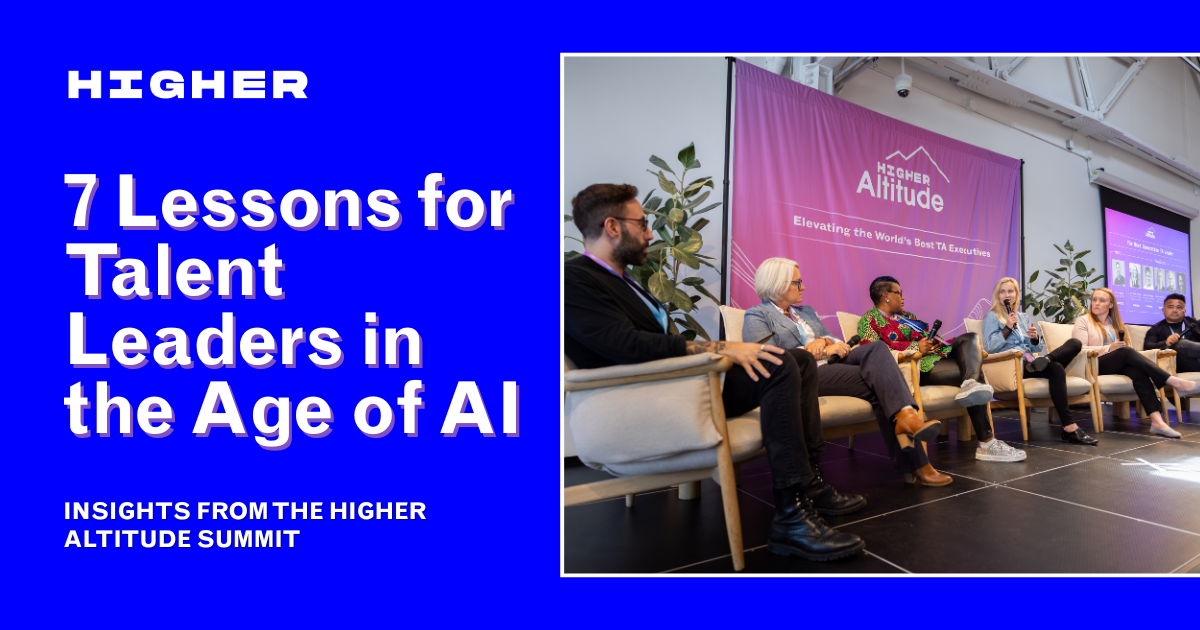7 Lessons for Talent Leaders in the Age of AI
Insights from the HIGHER Altitude Summit with leaders from Airbnb, Talkdesk, Automattic, LiveRamp & Ideals
In a time of relentless change, where technology accelerates and markets remain unpredictable the role of talent leaders is being redefined.
At the HIGHER Altitude Summit, a powerhouse panel of leaders from Airbnb, Talkdesk, Automattic, LiveRamp, and Ideals explored the emerging mindsets, skills, and strategies shaping the future of talent acquisition. Their diverse paths—spanning engineering, clinical psychology, open-source tech, and beyond—brought rich insight into what leadership in this space really requires.
Here are seven standout lessons that reflect the shifting foundation of the function.
1. Adopt a Go-to-Market Mindset
Talent acquisition must move beyond being a reactive, service-oriented function. Several panelists stressed the need for TA to position itself like a go-to-market function: strategic, revenue-aware, and embedded in business outcomes.
“We have to stop thinking of ourselves as a service organization… stop it with the whole ticketing system… We should start to think of how we can impact profits.” — José Benitez Cong, Global Head, Core Recruiting at Airbnb
This means understanding financial drivers like EBITDA margins and aligning hiring efforts to market share and growth objectives.
2. “Burn the Boat” and Rebuild
AI will reshape every corner of TA—but the real power lies not in layering tech on top of flawed systems, but in reimagining the systems completely. José Benitez Cong called for courage to “burn the boat,” leaving behind outdated processes and building anew with AI capabilities in mind.
“Here’s amazing technology being given to us today. How do we burn the boat that got us here and rebuild it.” — José Benitez Cong
Technology isn’t the differentiator—how we redesign with it is. Leaders must solve for the future, not just optimize the past.
3. Master Strategic Foresight and Agility
Kathrin Holzfurtner, former head of Global Head of Talent Acquisition at Ideals, emphasized the importance of “zooming out”—developing strategic foresight through scenario planning, cross-functional partnerships (especially with finance), and learning from fields like marketing.
“One capability I’ve been very deliberate about was strategic foresight… scenario building and stress-testing cross-functional people solutions for the future.” — Kathrin Holzfurtner
This blend of foresight and agility equips leaders to anticipate change instead of reacting to it.
4. Balance AI with Human Judgment
AI can accelerate change, but it can’t replace the human judgment required to make the right decisions. Karen Arnold, Global VP of Talent at Automattic, learned this firsthand when she scrapped her team’s old performance management process and built a new one with the help of Claude AI.
“We need human judgment to try to figure out what decisions we make about building it back up again.” — Karen Arnold
Success isn’t just about automating, it’s about pairing AI-driven efficiency with the empathy and discernment only humans can provide.
5. Prioritize Internal Mobility and Capability Building
TA is shifting from filling roles to enabling workforce evolution. Dr. Maisha Gray-Diggs, VP of Talent, Diversity, and Enablement at LiveRamp, emphasized org design, intentional intake conversations, and developing internal capabilities to reduce rework and attrition.
“I hate attrition… I make my teams triage whether we need this hire, or if we’re solving the wrong problem.
Slowing down to speed up is my rallying call.” — Dr. Maisha Gray-Diggs
6. Build Commercial Fluency to Earn Influence
To be seen as true business leaders, TA professionals must understand and speak the language of business. Dr. Shauna Geraghty, SVP of Global People & Talent at Talkdesk, shared how she embraced this shift:
“Immerse yourself. Don’t be shy. Ask for it. Listen to earnings calls—no one’s going to give us a seat, we have to earn it.” — Dr. Shauna Geraghty,
It’s about moving from operational reporting to metrics that drive the balance sheet.
7. Tell Data-Backed, Business-Relevant Stories
Data matters—but stories stick. Leaders must be able to translate complex insights into business narratives.
“Commercial facts capture the mind. But human stories make it stick.” — Kathrin Holzfurtner
High-signal metrics like new hire performance, ramp time, and hiring plan attainment can be used to tell stories that influence the C-suite.
Bonus Insight: Diverse Backgrounds Make Better Leaders
Panelists came from clinical psychology, engineering, and open-source communities. Their experiences bring fresh perspectives: systems thinking, behavior insight, and analytical rigor.
“I’m probably too data-driven at times, but my engineering background helps me pivot, see around corners, and fail fast.” — Dr. Maisha Gray-Diggs
“Turns out clinical psychology is incredibly useful in root-cause analysis, influencing execs, and scaling org culture.” — Dr. Shauna Geraghty
Leading the Change
The message from the HIGHER Altitude Summit is unmistakable: the role of the talent leader is undergoing a fundamental reinvention. It's no longer enough to be an expert in hiring. Today’s leaders must be commercially astute strategists, technologically savvy innovators, and deeply human connectors. The lessons from this panel provide a roadmap not just for adapting, but for leading the charge in building the resilient, high-performing organizations of the future.
These conversations are vital for navigating the challenges and opportunities ahead. To connect with other forward-thinking talent leaders and stay at the forefront of the industry, join the community at HIGHERHQ.com.






